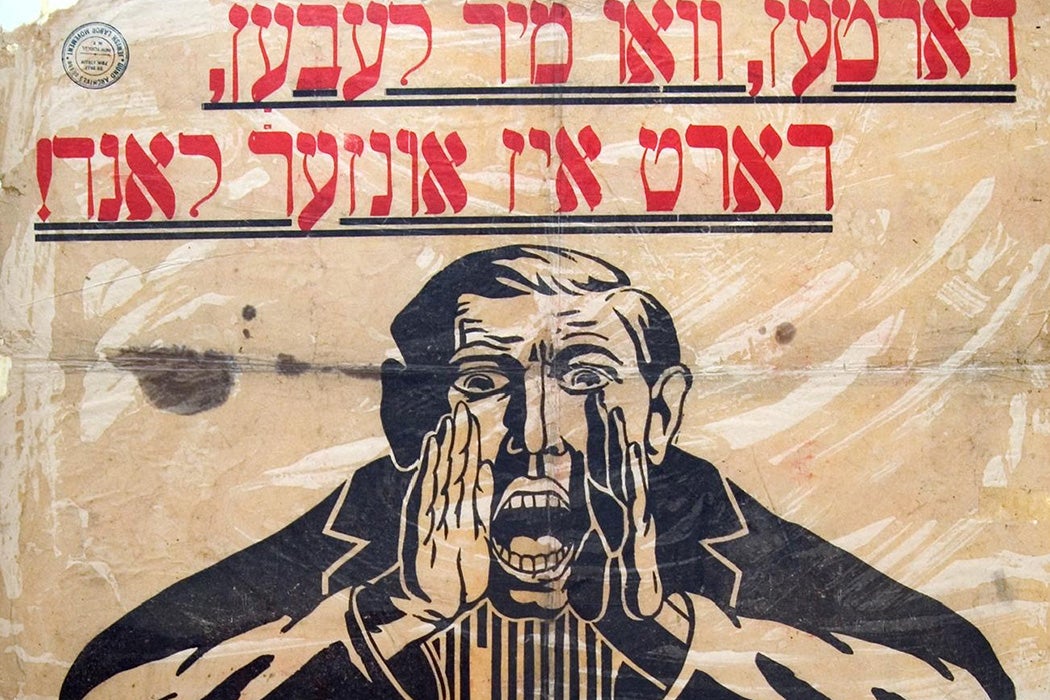After the genocide of World War II, Jewish communities had to rebuild their cultural practices and organizations. The ranks of the Jewish Labor Bund, a socialist group formed in the late nineteenth century to fight for Jewish emancipation, had been decimated during the Holocaust. Unlike many other Jewish organizations, the recovering Bund was a non-Zionist association with members who didn’t view Israel as the homeland. As historian David Slucki notes, “bundists emphasized the need to work and live together with all peoples and nations and to struggle for socialism alongside both Jews and non-Jews.”
The official membership of the bunds never exceeded 10,000. And even prior to the war, the ties between bundists were tested by migration from Eastern Europe to the United States; the forced migration of the war and the devastation of the Holocaust added more stress to these fragile ties. Even so, “[c]omrades from different communities were still connected with one another and still felt a kinship as bundists, as socialists, and as Jews that was unshakeable,” writes Slucki. The “bundist family” (bundishe mishpokhe) communicated with its members from Melbourne, Montevideo, and elsewhere.
Within this transnational framework, bundists emphasized “the right and responsibility of Jews to foster Jewish culture wherever they live.” Rather than focusing on the State of Israel as the primary definer of Jewish culture, “bundists lived a diasporic reality that carefully balanced the local and transnational,” making a space for themselves wherever they landed.
In the postwar years, bundist aspirations were shaped in part by politics greater than inter-Jewish communal problems. “The United States, held hostage by the onset of McCarthyism, was not conducive to leftist politics,” Slucki explains. Due to this, bundism never really took off there in the 1950s as it had in Eastern Europe in the early twentieth century. (The Jewish left was still involved in organizing in the US, just not explicitly as bundists. Leftist American Jews had helped kick off labor organizing among Jewish Russians in the early twentieth century, sending Yiddish organizing materials to Russia, for instance.)
Elsewhere, bundists were more visible and had more of a role in Jewish life in areas with smaller Jewish communities, such as in Australia and Mexico. Slucki notes that Melbourne’s “Bund is instructive as an example of a Bund organization that saw great success and influence in the local Jewish community and crafted their message in line with local circumstances.”
And despite bundists being historically non-Zionist, there existed an Israeli Bund, which “represented another case in which each Bund organization needed to respond separately to its own local conditions. Israel’s very existence presented the world movement’s adherents with a much more complex and even paradoxical reality, one that truly tested the world Bund’s new manifesto.”
Weekly Newsletter
While bundist leaders clashed over the directions the Jewish Labor Bund should take in the 1950s, the ways in which current and former bundists shaped the Jewish left in their respective countries and communities demonstrates the Bund’s strengths and legacy.
“The directions that the various groups took help expand our understanding of the anxieties, hopes, and relationships of Jewish communities around the world,” Slucki writes. “For those thousands involved directly or indirectly with the Bund…the movement played a very real and important role in what was a very turbulent time in their lives, marked by trauma, displacement, and resettlement.”
Support JSTOR Daily! Join our new membership program on Patreon today.







